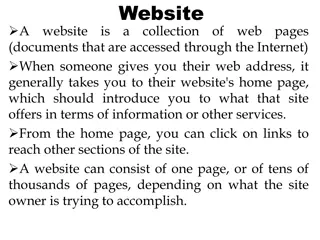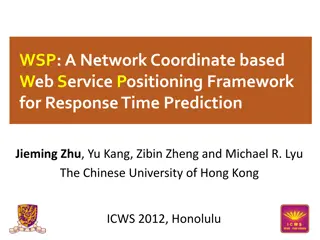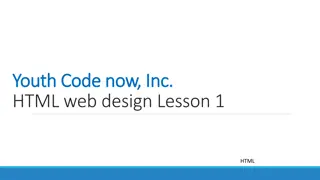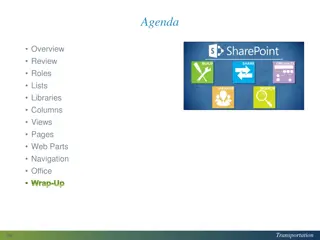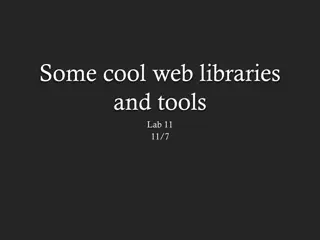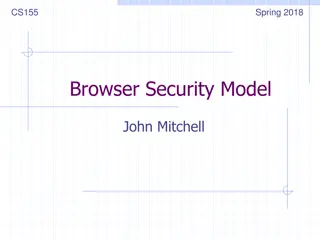Understanding Web Services and How They Work
Web services facilitate communication between applications using open standards such as HTML, XML, WSDL, and SOAP. This enables interoperability and the ability to expose existing code over the network, allowing various applications to interact and share data. Learn about the components of web services, how they function, and why they are essential in modern software development.
Download Presentation

Please find below an Image/Link to download the presentation.
The content on the website is provided AS IS for your information and personal use only. It may not be sold, licensed, or shared on other websites without obtaining consent from the author. Download presentation by click this link. If you encounter any issues during the download, it is possible that the publisher has removed the file from their server.
E N D
Presentation Transcript
Components of Web Services The basic web services platform is XML + HTTP. All the standard web services work using the following components SOAP (Simple Object Access Protocol) UDDI (Universal Description, Discovery and Integration) WSDL (Web Services Description Language)
How Does a Web Service Work? A web service enables communication among various applications by using open standards such as HTML, XML, WSDL, and SOAP. A web service takes the help of XML to tag the data SOAP to transfer a message WSDL to describe the availability of service. You can build a Java-based web service on Solaris that is accessible from your Visual Basic program that runs on Windows. You can also use C# to build new web services on Windows that can be invoked from your web application that is based on JavaServer Pages (JSP) and runs on Linux.
Example Consider a simple account-management and order processing system. The accounting personnel use a client application built with Visual Basic or JSP to create new accounts and enter new customer orders. The processing logic for this system is written in Java and resides on a Solaris machine, which also interacts with a database to store information. The steps to perform this operation are as follows The client program bundles the account registration information into a SOAP message. This SOAP message is sent to the web service as the body of an HTTP POST request. The web service unpacks the SOAP request and converts it into a command that the application can understand. The application processes the information as required and responds with a new unique account number for that customer.
Next, the web service packages the response into another SOAP message, which it sends back to the client program in response to its HTTP request. The client program unpacks the SOAP message to obtain the results of the account registration process.
Why Web Services? Exposing the Existing Function on the network A web service is a unit of managed code that can be remotely invoked using HTTP. That is, it can be activated using HTTP requests. Web services allow you to expose the functionality of your existing code over the network. Once it is exposed on the network, other applications can use the functionality of your program.
Interoperability Web services allow various applications to talk to each other and share data and services among themselves. Other applications can also use the web services. For example, a VB or .NET application can talk to Java web services and vice versa. Web services are used to make the application platform and technology independent.
Low Cost Communication Web services use SOAP over HTTP protocol, so you can use your existing low-cost internet for implementing web services. This solution is much less costly compared to proprietary solutions like EDI/B2B. Besides SOAP over HTTP, web services can also be implemented on other reliable transport mechanisms like FTP.
Ability to be Synchronous or Asynchronous Synchronicity refers to the binding of the client to the execution of the service. In synchronous invocations, the client blocks and waits for the service to complete its operation before continuing. Asynchronous operations allow a client to invoke a service and then execute other functions. Asynchronous clients retrieve their result at a later point in time, while synchronous clients receive their result when the service has completed. Asynchronous capability is a key factor in enabling loosely coupled systems.
Web Services - Architecture There are two ways to view the web service architecture The first is to examine the individual roles of each web service actor. The second is to examine the emerging web service protocol stack.
Web Service Roles There are three major roles within the web service architecture Service Provider This is the provider of the web service. The service provider implements the service and makes it available on the Internet. Service Requestor This is any consumer of the web service. The requestor utilizes an existing web service by opening a network connection and sending an XML request. Service Registry This is a logically centralized directory of services. The registry provides a central place where developers can publish new services or find existing ones. It therefore serves as a centralized clearing house for companies and their services.
Web services architecture: the service provider sends a WSDL file to UDDI. The service requester contacts UDDI to find out who is the provider for the data it needs, and then it contacts the service provider using the SOAP protocol. The service provider validates the service request and sends structured data in an XML file, using the SOAP protocol. This XML file would be validated again by the service requester using an XSD file.
Web Service Protocol Stack A second option for viewing the web service architecture is to examine the emerging web service protocol stack. The stack is still evolving, but currently has four main layers. Service Transport This layer is responsible for transporting messages between applications. Currently, this layer includes Hyper Text Transport Protocol (HTTP), Simple Mail Transfer Protocol (SMTP), File Transfer Protocol (FTP), and newer protocols such as Blocks Extensible Exchange Protocol (BEEP). XML Messaging This layer is responsible for encoding messages in a common XML format so that messages can be understood at either end. Currently, this layer includes XML-RPC and SOAP. Service Description This layer is responsible for describing the public interface to a specific web service. Currently, service description is handled via the Web Service Description Language (WSDL). Service Discovery This layer is responsible for centralizing services into a common registry and providing easy publish/find functionality. Currently, service discovery is handled via Universal Description, Discovery, and Integration (UDDI). As web services evolve, additional layers may be added and additional technologies may be added to each layer.
Few Words about Service Transport The bottom of the web service protocol stack is service transport. This layer is responsible for actually transporting XML messages between two computers. Hyper Text Transfer Protocol (HTTP) Currently, HTTP is the most popular option for service transport. HTTP is simple, stable, and widely deployed. Furthermore, most firewalls allow HTTP traffic. This allows XMLRPC or SOAP messages to masquerade as HTTP messages. This is good if you want to integrate remote applications, but it does raise a number of security concerns.ise a number of security concerns. Blocks Extensible Exchange Protocol (BEEP) This is a promising alternative to HTTP. BEEP is a new Internet Engineering Task Force (IETF) framework for building new protocols. BEEP is layered directly on TCP and includes a number of built-in features, including an initial handshake protocol, authentication, security, and error handling. Using BEEP, one can create new protocols for a variety of applications, including instant messaging, file transfer, content syndication, and network management. SOAP is not tied to any specific transport protocol. In fact, you can use SOAP via HTTP, SMTP, or FTP. One promising idea is therefore to use SOAP over BEEP.
Web Services - Components Over the past few years, three primary technologies have emerged as worldwide standards that make up the core of today's web services technology. These technologies are: 1. XML-RPC This is the simplest XML-based protocol for exchanging information between computers. XML-RPC is a simple protocol that uses XML messages to perform RPCs. Requests are encoded in XML and sent via HTTP POST. XML responses are embedded in the body of the HTTP response. XML-RPC is platform-independent. XML-RPC allows diverse applications to communicate. A Java client can speak XML-RPC to a Perl server. XML-RPC is the easiest way to get started with web services.
SOAP SOAP is an XML-based protocol for exchanging information between computers. SOAP is a communication protocol. SOAP is for communication between applications. SOAP is a format for sending messages. SOAP is designed to communicate via Internet. SOAP is platform independent. SOAP is language independent. SOAP is simple and extensible. SOAP allows you to get around firewalls. SOAP will be developed as a W3C standard.
WSDL WSDL is an XML-based language for describing web services and how to access them. WSDL stands for Web Services Description Language. WSDL was developed jointly by Microsoft and IBM. WSDL is an XML based protocol for information exchange in decentralized and distributed environments. WSDL is the standard format for describing a web service. WSDL definition describes how to access a web service and what operations it will perform. WSDL is a language for describing how to interface with XML-based services. WSDL is an integral part of UDDI, an XML-based worldwide business registry. WSDL is the language that UDDI uses. WSDL is pronounced as 'wiz-dull' and spelled out as 'W-S-D-L'.
UDDI UDDI is an XML-based standard for describing, publishing, and finding web services. UDDI stands for Universal Description, Discovery, and Integration. UDDI is a specification for a distributed registry of web services. UDDI is platform independent, open framework. UDDI can communicate via SOAP, CORBA, and Java RMI Protocol. UDDI uses WSDL to describe interfaces to web services. UDDI is seen with SOAP and WSDL as one of the three foundation standards of web services. UDDI is an open industry initiative enabling businesses to discover each other and define how they interact over the Internet.









